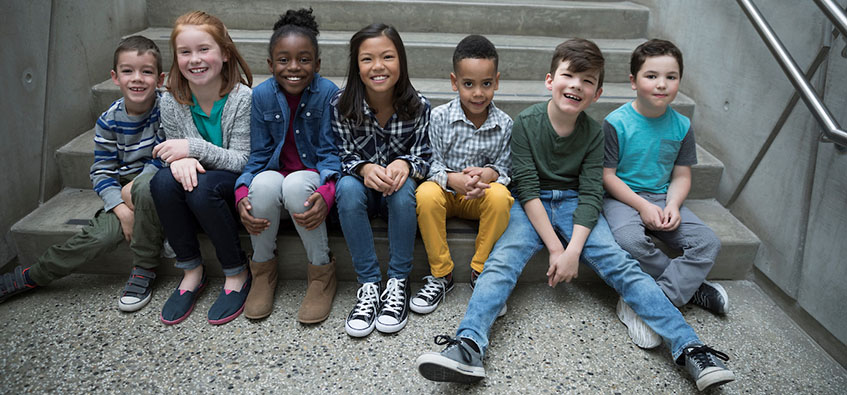A child’s world is infinite. From the day a child enters the world, their brains are constantly making connections. These connections help create what we, as adults, see as normal functions of the human body. A child simultaneously intakes information not only given from their surroundings, but from an instinct embedded in their brain, and uses these phenomena throughout their growth. As children develop their newfound skills, such as motor skills, language acquisition, and social communication, there is a crucial period in which a child’s development is sensitive. External circumstances, defects, and societal change can alter or delay a child’s progress in obtaining language skills and could result in long-term effects well into adulthood. While children progress through there education, external circumstances and long-term effects can vary depending on the child. Studying the ways children communicate can help give clarity for adults in how to adjust and learn different forms of communication to interact better with their surroundings.
The very beginning of a child’s life is intriguing to say the least. As children grow, their minds make connections, expand ideas, and grasp theories that all indicate a higher stimulus that seems inexplicable. When a baby, probably between 6-8 months, begins to “babble,” 1 that is when a child demonstrates understanding and recognition of sounds that they have been hearing around them. This moment is part of the process of language acquisition; it is when a human recognizes and understands language. “Language we hear can have a strong effect on the ways that we understand the world.”2 All humans talk.3 Language is an essential part of human life.
At birth, a human’s brain uses neurons and synapses to develop connections; those connections form and help create the wonder of how the brain works. Tons of these synapses work to help a child develop and gain skills. A child between the ages of nine months to two years (depending on the child) has about 50% more synapses than the adult.4 The peak for synapses is age four and levels around age seven (of course, remember, every child is differen), and these processes do not necessarily occur on the same timeline in every child. As we age, synapses start to deplete from our brains. It takes adults more time and effort to learn different forms of communication then a child in their early stages of learning. 5 While still in the early staged of childhood, children have an ability to adapt to different forms of language, almost as an instant reaction. Children’s adaptation is quite agile during the ages of three and seven, which is called the critical period. The critical period is a timeline in a child’s brain development and growth in which it is easy to acquire an ability, which, if not mastered, becomes difficult to obtain in later years.6

As children, our brains are like sponges; we can absorb knowledge from our surroundings, and, if mastered during the critical period, it can be carried into adulthood. One of these specific types of knowledge is communication. Adults struggle with communication as they get older, yet children can change and expand their communication easily. As adults, we grow and forget the beginning process of learning language. We forget how we acquired the ability of language because it comes so naturally.7 Every child is different, and every child has their own way of grasping what is being taught to them. Throughout our life, we carry our communication line, and, as we grow, we develop it. For children, there can be multiple occurrences and situations that affect their ability to learn. In the critical period, children could be subjected to external factors that could alter the way they develop. These external factors may affect the way they communicate their needs throughout their development.8 External factors vary depending on the specific circumstance of the child. Those factors can eventually lead to communication problems as adults. These specific experiences can have profound impacts on one’s communication line.
In creating our communication, we begin the stages with body movements. Babies tend to use their body parts, most commonly their feet, to try and communicate their needs and wants. Body movements correlate with the babble phase,9 and we then proceed into the acquisition of grammar during the critical period. This is where communication starts to mold into the individual’s communication line. Some say we create our communication line from what has affected us and there are others that say there is a programmed process of language that is biologically embedded into our brains.10 This is called Nature vs. Nurture debate. Nature is the view of language as a natural instinct of all humans.11 Humans are wired with the ability to communicate. Nurture argues that language must be learned. Darwin even concluded that the human language is the same as the instinct to acquire art.12 Communication is not quite so easily defined.13 To establish a definition we need to remember, communication is endless. An example to imagine is a scene from the movie Avatar. In the movie, there is a doctor named Dr. Grace, who studies neurology and connections. There is a moment in which she has to explain the interactions that the native people have with the land.14 When the doctor describes the trees and shows an analysis of these “connections,” those connections could be visualized as our own human communication lines.

In truth, both nature and nurture are correlated. Communication lines grow as we do. As humans we crave communication. Language is tightly woven into human experiences.15 It is so tightly woven, that communication is our natural ability to interact with anything among our world. Humans will even talk to themselves. Nurture is also intertwined with communication nature. Nurture consists of the external factors that affect an individual and affect our language acquisition. External factors can include traumatic events that can give a child life-long problems.16 According to information from the US Department of Health and Human Services Administration on Children, Youth and Families, 2005, “every year approximately 1 million infants, children, and adolescents”17 are victimized. Victimization is defined as being the recipient of an abusive action, including abuse and/or neglect, in life-long experiences or in single interactions. Importantly, every child is different, and every child reacts differently.
The effects of being victimized can affect a child neurologically and psychosocially.18 There are individuals who can move past being victimized as they grow, yet there are others who create dysfunctional or addictive behaviors that build into their cycle of living.19 These cyclical behaviors can seem so natural to individuals that most of the time they don’t realize what is specifically causing them, and this affects their communication line. When children are victimized, that initial act can create an array of behavioral manifestations.20 Specifically in language, if a child is shown to have academic difficulties, it could result from a traumatic event. Most often, behaviorial issues overlook the blocked communication line, but these behaviors can influence children’s issues in language.21 Each age group has a different range of behavioral modifications that correlate difficulties in communicating their needs. When unable to express themselves, children build behavior issues that shape the way they communicate and, without proper analyzes, can carry the issues well into adulthood. Understanding youth and their development is important because it helps distinguish the differences in the cause(s) of blocked/delayed language development.

Anomalies or delays in language development
are important indicators in distinguishing another form of communication issues amongst children.22 Children with disabilities have notable characteristics that pertain to problems with communication. Disabilities affect a child’s ability to process information and can cause delays in development, specifically communication. The difficulty in understanding the child’s communication line depends on the particular disability. Each disability manifest its own manner of cognitive skills that relate to language development in a unique and often not well understood
manner.23 With disabled children, adults seem to adjust to the difficulty or at least attempt to without hesitation. Yet, with victimized children, adults consider this issue to be behavioral and there may be less initiative to understand the communication line affected by victimization. Teachers, researchers, and scientists make it their life’s work to understand. But when you take a look at the “average” individual, who could even have communication issues themselves, their natural instinct is to try and connect with another communication line, in any way possible.
Recently, I met a man whose brother was disabled with Down Syndrome. Down Syndrome is a genetic disorder with cognitive impairment, which can cause physical and intellectual delays from birth.24 As our conversation became an interview, I learned that the man was in his early 20’s, from a rural background that would be considered less than prestigious. Both his father and his brother’s father were incarcerated. But, as I discovered, this individual had a strong motivation to understand how to communicate with his brother. This young gentleman’s instinct was to connect with his brother’s communication line, and what’s astonishing was his response to me. He connected his initiative to understand his brother as, “That’s who I have, he’s family. I’m the only person he has.” As I listened, I realized that I had initially underestimated this individual, based on his background. I asked next, “How do you communicate with him?” and he explained to me that his brother understands his English. He speaks clearly, his brother hears and understands English, but his brother only responds in sign language. He proved this, by signing a response to the question “Do you know sign language?” This gentleman took the initiative to learn sign language in an effort to connect to his brother, while using his natural instinctive and adaptable communication line. At this moment, he had succeeded in intertwining nature vs nurture. This gentleman used the nurture of family attributes and combined it with the urge of communication lines trying to connect.
That adaptation in children, observed in this gentleman’s desire to adapt to his brother, is an ability that most adults forget how to use as they age. A human’s communication line seems to be the most fragile out of all the abilities a of which the human brain is mentally capable. Children can re-teach adults how to communicate better. As a child, the communication line is agile and adaptable. Children find ways to connection with other children despite developmental delays during childhood. As adults there needs to be a reminder that our communication line is still adaptable. Whether it’s in becoming a parent or in the initial interaction with any child, adults must understand their communication line and remember how to reform the adaptability. When an adult interacts with a child, they specifically must change and emulate the communication of the child to be able to infer and suggest what the child is trying to communicate. That same adaptability should be re-taught to adults, in an effort to form better communication lines between adults and children, the mini adults of the future.
To the man I met at Social Spot. I may have not gotten your name, but I thank you for talking about your family. It was an honor to be humbled by your experiences. I underestimated you and this article is dedicated to you and your brother. Thank you, truly.
- Schacter, D. L., Gilbert, D. T., & Wegner, D. M. (2011). Psychology. Worth Publishers. http://archive.org/details/psychology0000scha ↵
- Bowerman, M., Levinson, S. C., & Levinson, S. (2001). Language acquisition and conceptual development. Cambridge University Press. ↵
- Gleitman, L. R., Osherson, D. N., & Liberman, M. (1995). An invitation to cognitive science: Language. MIT Press. ↵
- Gleitman, L. R., Osherson, D. N., & Liberman, M. (1995). An invitation to cognitive science: Language. MIT Press. ↵
- Gleitman, L. R., Osherson, D. N., & Liberman, M. (1995). An invitation to cognitive science: Language. MIT Press. ↵
- Putnam, F. W. (2006). The impact of trauma on child development. Juvenile and Family Court Journal 57(1), 1-12. https://doi.org/10.1111/j.1755-6988.2006.tb00110.x ↵
- Pinker, S. (2000). The language instinct: How the mind creates language. HarperCollins. ↵
- Streeck-Fischer, A., & Bessel, A. van der Kolk. (2000). Down will come baby, cradle and all: Diagnostic and therapeutic implications of chronic trauma on child development. Australian & New Zealand Journal of Psychiatry, 34(6), 903–918. https://doi.org/10.1080/000486700265 ↵
- Schacter, D. L., Gilbert, D. T., & Wegner, D. M. (2011). Psychology. Worth Publishers. http://archive.org/details/psychology0000scha ↵
- Pinker, S. (2000). The language instinct: How the mind creates language. HarperCollins. ↵
- Pinker, S. (2000). The language instinct: How the mind creates language. HarperCollins. ↵
- Putnam, F. W. (2006). The impact of trauma on child development. Juvenile and Family Court Journal 57(1), 1-12. https://doi.org/10.1111/j.1755-6988.2006.tb00110.x ↵
- Littlejohn, S. W., & Foss, K. A. (2007). Theories of Human Communication (9th ed.). Wadsworth. ↵
- Cameron, J. (Producer & Director), & Landau, J. (Producer). (2009). Avatar (motion picture). Twentieth Century Fox. ↵
- Pinker, S. (2000). The language instinct: How the mind creates language. HarperCollins. ↵
- Gabowitz, D., Zucker, M., & Cook, A. (2008). Neuropsychological assessment in clinical evaluation of children and adolescents with complex trauma. Journal of Child & Adolescent Trauma, 1(2), 163-178. https://doi.org/10.1080/19361520802003822 ↵
- Putnam, F. W. (2006). The impact of trauma on child development. Juvenile and Family Court Journal 57(1), 1-12. https://doi.org/10.1111/j.1755-6988.2006.tb00110.x ↵
- Putnam, F. W. (2006). The impact of trauma on child development. Juvenile and Family Court Journal 57(1), 1-12. https://doi.org/10.1111/j.1755-6988.2006.tb00110.x ↵
- Putnam, F. W. (2006). The impact of trauma on child development. Juvenile and Family Court Journal 57(1), 1-12. https://doi.org/10.1111/j.1755-6988.2006.tb00110.x ↵
- Gabowitz, D., Zucker, M., & Cook, A. (2008). Neuropsychological assessment in clinical evaluation of children and adolescents with complex trauma. Journal of Child & Adolescent Trauma, 1(2), 163-178. https://doi.org/10.1080/19361520802003822 ↵
- Gabowitz, D., Zucker, M., & Cook, A. (2008). Neuropsychological assessment in clinical evaluation of children and adolescents with complex trauma. Journal of Child & Adolescent Trauma, 1(2), 163-178. https://doi.org/10.1080/19361520802003822 ↵
- Dolan, T. R. (1997). Overview: Communication processes and developmental disabilities. Mental Retardation and Developmental Disabilities Research Reviews, 3(4), 279–281. https://doi.org/10.1002/(SICI)1098-2779(1997)3:4<279::AID-MRDD1>3.0.CO;2-J ↵
- Dolan, T. R. (1997). Overview: Communication processes and developmental disabilities. Mental Retardation and Developmental Disabilities Research Reviews, 3(4), 279–281. https://doi.org/10.1002/(SICI)1098-2779(1997)3:4<279::AID-MRDD1>3.0.CO;2-J ↵
- FAQ and facts about Down Syndrome. (n.d.) Global Down Syndrome Foundation. https://www.globaldownsyndrome.org/about-down-syndrome/facts-about-down-syndrome/ ↵




20 comments
Kayla Braxton-Young
This was one of the best articles that I have read. It really is an interesting topic and anything about children and kids I just love. I want to be a 2nd or 3rd-grade teacher, so teaching children and learning about children is just something I am really interested in and enjoy doing. This article really provided a lot of information and I really enjoyed reading it. This was a great article and it was something big on something I really enjoy doing.
Makayla Soto
I think this article opens up doors and conversation of how much potential kids have and how intelligent they are! You give us detail in chronological order as well which I appreciate! You did a good job explaining to us the timeline and background of how child’s develop and their behavior and brain is. Overall a really good and educational article!
Esteban Serrano
Hey Michaela, this was a great article! Well done on the research part of it. Kids have very unique mindsets. These little ones are indeed the future adults or some may call the “minis of us.” A lot of them develop minds like adults, with psychological responses like echolalia, which essentially is a natural response to words children hear, then will repeat it. This could be froma movie, friend, or even a parent. That’s how I feel children pick up a lot of talents from their parents is being exposed to what their parents are doing. For instance, if the dad is a doctor, and a child observes, their curious mind will interest them and only make them more likely to become a doctor as well. Nonetheless, I loved the research and learning from this article! Thanks for writing!
Jocelyn Elias
Very informative article. Early childhood development is very important and crucial to everyone. There are many factors that contribute to making a good development and a not so good one. I really appreciate how you go in depth and explain minor factors that after seeing their effects are actually quite important factors. I think your article explained very well how nature and nurturing is very important and crucial.
Dejah Garcia
I thought it was pretty interesting read the Interpretation of a child mindset. I thought it was interesting to see the milestone of development throughout the years of a child’s life. This stood out to me because it helped me to gain an understanding of the learning pace of children. I think it’s fascinating to think how fast a child starts to learn and Develop life skills. Overall, I loved your article! I thought it was awesome keep up the great work.
Emily Rodriguez
This was a very well informative article on child development. As an education major, I’ve had to learn all about a child’s development and the different periods children go to. This article was very well-written and explained these periods in a great way! It’s important to know how children develop and learn. For example, one of the biggest ways children learn is through play. But oftentimes, play is seen as something that is overlooked or not imperative for a child’s learning. Adults need to understand children’s development because they will soon be the ones making differences/changes in the world.
Alia Hernandez Daraiseh
Reading this article has given me the opportunity to learn more about childhood development, and how critical the early stages of life is to each individual. I have always been fascinated with psychology, and now understanding that nature and nurture can go hand in hand, is a different approach I did not think to take. It was always black and white, but it can also be gray as well. Children can be easily affected by things that us adults do not take as seriously, and unfortunately we don’t take as seriously the necessary communication skills to understand and adapt to children as we should be doing.
Charles Lares
the article was an amazing read. I recently took a psych course and one of the topics was child development that was taught by one of my professors who focused on atypical/child development. It is amazing to see how much a child can learn within the first year of being born, the neurology that goes into it and the processing speed is very incredible so it still continues to amaze me how much a child learns through many techniques.
Elizabeth Saxon
I really enjoy all the science you put behind your article. I found the image you used very intriguing by letting us know the capacity of what a child’s brain consists of at a certain age. It fascinated me how intense children can pick up on things you wouldn’t think they would pick up on. I love how you incorporated your own experience to add to your article.
Eliza Merrion
I really enjoyed reading this article and I could really feel your passion for it in the text. The psychology and science behind a child’s brain from birth is so interesting. On the same note it is also very interesting to hear about how certain things can affect a child’s brain. I really enjoyed how you brought your own story into the article and made it more personal. I also like how you connected communication as a major part of a child’s development, it something I think is extremely important.